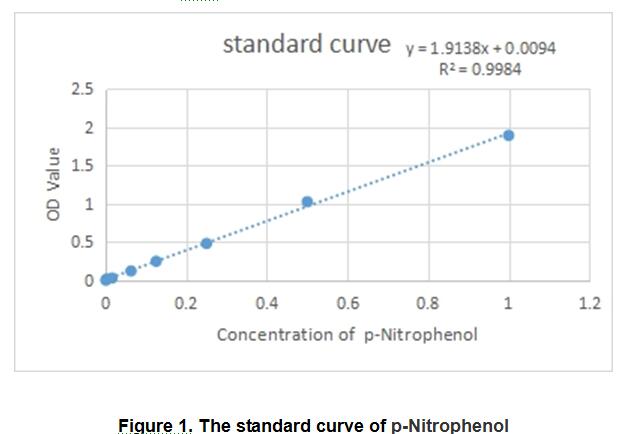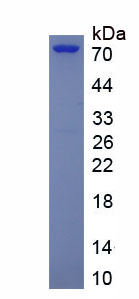Active Acid Sphingomyelinase (ASM) 

SMPD1; NPD; SMase; aSMase; Sphingomyelin Phosphodiesterase 1,Acid Lysosomal; Simply Sphingomyelinase
- UOM
- FOB US$ 325.00 US$ 812.00 US$ 1,624.00 US$ 4,872.00 US$ 12,180.00
- Quantity
Overview
Properties
- Product No.APB360Mu61
- Organism SpeciesMus musculus (Mouse) Same name, Different species.
- ApplicationsCell culture; Activity Assays.
Research use only - DownloadInstruction Manual
- CategoryEnzyme & KinaseMetabolic pathwayNeuro science
- Buffer FormulationPBS, pH7.4, containing 0.01% SKL, 1mM DTT, 5% Trehalose and Proclin300.
- Traits Freeze-dried powder, Purity > 97%
- Isoelectric Point6.9
Sign into your account
Share a new citation as an author
Upload your experimental result
Review

Contact us
Please fill in the blank.
Activity test

Sphingomyelin phosphodiesterase 1 (SMPD1), also known as acid sphingomyelinase (ASM), belongs to the sphingomyelin phosphodiesterase family. The protein Converts sphingomyelin to ceramide. ASM also has phospholipase C activities toward 1,2-diacylglycerolphosphocholine and 1,2-diacylglycerolphosphoglycerol.
Thus, the recombinant mouse ASM activity was measured by its ability to hydrolyze 2-N-Hexadecanoylamino-4-nitrophenylphosphorylcholine (HDA-PC) to p-Nitrophenol. The reaction was performed in 50mM MES, 0.5 µM ZnCl2, pH 7.5 ( Assay Buffer), initiated by addition 50μL of various concentrations of ASM (diluted with Assay Buffer) to 50 µL of 1mM Substrate HDA-PC ( 50mM stock solution in methanol, diluted with Assay Buffer). Incubated at room temperature for 20 minutes in the dark, then read at a wavelength of 405 nm.
Usage
Reconstitute in 10mM PBS (pH7.4) to a concentration of 0.1-1.0 mg/mL. Do not vortex.
Storage
Avoid repeated freeze/thaw cycles. Store at 2-8°C for one month. Aliquot and store at -80°C for 12 months.
Stability
The thermal stability is described by the loss rate. The loss rate was determined by accelerated thermal degradation test, that is, incubate the protein at 37°C for 48h, and no obvious degradation and precipitation were observed. The loss rate is less than 5% within the expiration date under appropriate storage condition.
Increment services
-
 BCA Protein Quantification Kit
BCA Protein Quantification Kit
-
 Molecular Mass Marker for Protein
Molecular Mass Marker for Protein
-
 Monoclonal Antibody Customized Service
Monoclonal Antibody Customized Service
-
 Polyclonal Antibody Customized Service
Polyclonal Antibody Customized Service
-
 Protein Activity Test Experiment Service
Protein Activity Test Experiment Service
-
 Electrophoretic Mobility Shift Assay (EMSA) Experiment Service
Electrophoretic Mobility Shift Assay (EMSA) Experiment Service
-
 Buffer
Buffer
-
 Lentivirus Packaging Experiment Service
Lentivirus Packaging Experiment Service
-
 Adenovirus Packaging Experiment Service
Adenovirus Packaging Experiment Service
-
 Real Time PCR Experimental Service
Real Time PCR Experimental Service
-
 Spike RBD Protein (S-RBD)
Spike RBD Protein (S-RBD)
-
 Protein G
Protein G
-
 Protein A
Protein A
Citations
- Acid sphingomyelinase is activated in sickle cell erythrocytes and contributes to inflammatory microparticle generation in SCDPubmed:25075126
- Increase in acid sphingomyelinase level in human retinal endothelial cells and CD34+ circulating angiogenic cells isolated from diabetic individuals is associated with dysfunctional retinal vasculature and vascular repair process in diabetes10.1016/j.jacl.2017.03.007
- Fenofibrate decreases plasma ceramide in type 2 diabetes patients: A novel marker of CVD?pubmed:28499696
- Acid Sphingomyelinase and Acid ¦Â-Glucosidase 1 Exert Opposite Effects on Interleukin-1¦Â-Induced Interleukin 6 Production in Rheumatoid Arthritis Fibroblast-Like Synoviocytes33665756
- Evaluation of sphingolipid metabolism on diabetic retinopathy34708809








